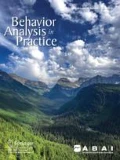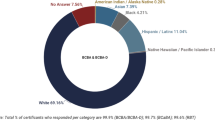Abstract
This review addresses multilingual diversity within the field of Applied Behavior Analysis (ABA) as it relates to treatment for autism spectrum disorders (ASD). The United States was founded as a diverse, multicultural “melting pot” and migration patterns continue to increase cultural and linguistic diversity, making it increasingly important to address these issues within the field of ABA. The role of multilingualism in ABA treatment for autism has scarcely been addressed in practice or in research and yet these factors likely impact the ABA treatment process significantly. The purpose of this review is to discuss how multilingualism might be better addressed within the field of ABA. We briefly review the very small amount of existing research on multilingual approaches when using ABA and discuss directions for future research. In addition, we discuss potential future directions for the field, in terms of increasing the number of international students in graduate programs, enhancing diversity curricula within graduate programs and continuing education, and efforts by professional organizations to address diversity.
Similar content being viewed by others

References
Altman, S., Stephens, G., & Yates, A. (2011). The Invisible Uninsured: Non-Citizens and Access to Health Care Coverage Under the Affordable Care Act. Pub. Int. L. Rep., 17, 230.
American Psychiatric Association. (2013). Diagnostic and statistical manual of mental disorders (5th ed.). Arlington, VA: American Psychiatric Publishing.
Baio, J., Wiggins, L., Christensen, D. L., et al. (2018). Prevalence of Autism Spectrum Disorder Among Children Aged 8 Years — Autism and Developmental Disabilities Monitoring Network, 11 Sites, United States, 2014. MMWR Surveill Summ, 67(SS-6), 1–23. https://doi.org/10.15585/mmwr.ss6706a1.
Baker, C. (2011). Foundations of Bilingual Education and Bilingualism (5th ed.). Bristol: Multilingual Matters.
Barbera, M. L. (2007). The verbal behavior approach: How to teach children with autism and related disorders. Jessica Kingsley Publishers.
Behavior Analyst Certification Board. (2014). Professional and ethical compliance code for behavior analysts. Littleton, CO: Author.
Bolling, M. Y. (2002). Research and representation: a conundrum for behavior analysts. Behavior and Social Issues, 12, 19–28.
Carr, E. G., & Durand, V. M. (1985). Reducing behavior problems through functional communication training. Journal of Applied Behavior Analysis, 18(2), 111–126.
Cook, P., Cook, M., Tran, L., & Tu, W. (1997). Children enabling change: A multicultural, participatory, community-based rehabilitation research project involving Chinese children with disabilities and their families. In Child and Youth Care Forum (Vol. 26, No. 3, pp. 205-219). Kluwer Academic Publishers-Human Sciences Press.
Cooper, J. O., Heron, T. E., & Heward, W. L. (2007). Applied behavior analysis. Upper Saddle River, NJ: Prentice Hall.
Daley, T. C. (2002). The need for cross-cultural research on the pervasive developmental disorders. Transcultural Psychiatry, 39(4), 531–550.
Dalmau, Y. C. P., Wacker, D. P., Harding, J. W., Berg, W. K., Schieltz, K. M., Lee, J. F., et al. (2011). A preliminary evaluation of functional communication training effectiveness and language preference when Spanish and English are manipulated. Journal of Behavioral Education, 20(4), 233–251.
Drysdale, H., van der Meer, L., & Kagohara, D. (2015). Children with autism spectrum disorder from bilingual families: A systematic review. Review Journal of Autism and Developmental Disorders, 2(1), 26–38.
Dyches, T. T., Wilder, L. K., Sudweeks, R. R., Obiakor, F. E., & Algozzine, B. (2004). Multicultural issues in autism. Journal of Autism and Developmental Disorders, 34(2), 211–222.
Fiorile, C. A., & Greer, R. D. (2007). The induction of naming in children with no prior tact responses as a function of multiple exemplar histories of instruction. The Analysis of Verbal Behavior, 23(1), 71–87.
Fletcher, L., & Hayes, S. C. (2005). Relational frame theory, acceptance and commitment therapy, and a functional analytic definition of mindfulness. Journal of Rational-Emotive and Cognitive-Behavior Therapy, 23(4), 315–336.
Fong, E. H., Catagnus, R. M., Brodhead, M. T., Quigley, S., & Field, S. (2016). Developing the cultural awareness skills of behavior analysts. Behavior Analysis in Practice, 9(1), 84–94.
Fong, E. H., Ficklin, S., & Lee, H. Y. (2017). Increasing cultural understanding and diversity in applied behavior analysis. Behavior Analysis: Research and Practice, 17(2), 103.
Greer, R. D., Stolfi, L., Chavez-Brown, M., & Rivera-Valdes, C. (2005). The emergence of the listener to speaker component of naming in children as a function of multiple exemplar instruction. The Analysis of Verbal Behavior, 21(1), 123–134.
Hambly, C., & Fombonne, E. (2012). The impact of bilingual environments on language development in children with autism spectrum disorders. Journal of Autism and Developmental Disorders, 42(7), 1342–1352.
Institute of International Education. (2016). "International Students by Academic Level, 2014/15 - 2015/16." Open Doors Report on International Educational Exchange. Retrieved from http://www.iie.org/opendoors.
Kay-Raining Bird, E., Lamond, E., & Holden, J. (2012). Survey of bilingualism in autism spectrum disorders. International Journal of Language & Communication Disorders, 47(1), 52–64.
Kitzhaber, S.. (2012). Interventions for Multicultural Children with Autism. Retrieved from Sophia, the St. Catherine University repository website: https://sophia.stkate.edu/msw_papers/118.
Lang, R., Rispoli, M., Sigafoos, J., Lancioni, G., Andrews, A., & Ortega, L. (2011). Effects of language of instruction on response accuracy and challenging behavior in a child with autism. Journal of Behavioral Education, 20(4), 252–259.
Lim, N., & Charlop, M. H. (2018). Effects of English versus heritage language on play in bilingually exposed children with autism spectrum disorder. Behavioral Interventions, 33(4), 339-351.
Liptak, G. S., Stuart, T., & Auinger, P. (2006). Health care utilization and expenditures for children with autism: data from US national samples. Journal of autism and developmental disorders, 36(7), 871–879.
Lovaas, I. O. (1987). Behavioral treatment and normal educational and intellectual functioning in young autistic children. Journal of Consulting and Clinical Psychology, 55, 3–9.
Matsumoto, D. (2001). The handbook of culture and psychology. London: Oxford University Press.
Morrier, M. J., Hess, K. L., & Heflin, L. J. (2008). Ethnic Disproportionality in Students with Autism Spectrum Disorders. Multicultural education, 16(1), 31–38.
Mueller, T. G., Singer, G. H., & Grace, E. J. (2004). The individuals with disabilities education act and California's proposition 227: Implications for English language learners with special needs. Bilingual Research Journal, 28(2), 231–251.
National Autism Center. (2009). National Standards Report - Addressing the need for evidence-based practice guidelines for Autism Spectrum Disorders. Massachusetts: National Autism Center.
Ohashi, J. K., Mirenda, P., Marinova-Todd, S., Hambly, C., Fombonne, E., Szatmari, P., et al. (2012). Comparing early language development in monolingual-and bilingual-exposed young children with autism spectrum disorders. Research in Autism Spectrum Disorders, 6(2), 890–897.
Perozzi, J. A., & Sanchez, M. L. C. (1992). The effect of instruction in L1 on receptive acquisition of L2 for bilingual children with language delay. Language, Speech, and Hearing Services in Schools, 23(4), 348-352.
Ravindran, N., & Myers, B. J. (2012). Cultural influences on perceptions of health, illness, and disability: A review and focus on autism. Journal of Child and Family Studies, 21(2), 311–319.
Rispoli, M., O’Reilly, M., Lang, R., Sigafoos, J., Mulloy, A., Aguilar, J., & Singer, G. (2011). Effects of language of implementation on functional analysis outcomes. Journal of Behavioral Education, 20(4), 224–232.
Salend, S. J., & Taylor, L. S. (2002). Cultural perspectives: Missing pieces in the functional assessment process. Intervention in School and Clinic, 38(2), 104–112.
Sen, E., & Yurtsever, S. (2007). Difficulties experienced by families with disabled children. Journal for Specialists in Pediatric Nursing, 12(4), 238–252.
Skinner, B. F. (1957). Verbal behavior. CT: Appleton-Century-Crofts.
Skinner, B. F. (1972). Beyond freedom and dignity. New York: Bantam Books.
Sugai, G., O’Keeffe, B. V., & Fallon, L. M. (2012). A contextual consideration of culture and school-wide positive behavior support. Journal of Positive Behavior Interventions, 14(4), 197–208.
Tanaka-Matsumi, J., Seiden, D. Y., & Lam, K. N. (1996). The Culturally Informed Functional Assessment (CIFA) Interview: A strategy for cross-cultural behavioral practice. Cognitive and Behavioral Practice, 3(2), 215–233.
Thordardottir, E. (2010). Towards evidence-based practice in language intervention for bilingual children. Journal of Communication Disorders, 43, 523–537.
Thordardottir, E. T., Weismer, S. E., & Smith, M. E. (1997). Vocabulary learning in bilingual and monolingual clinical intervention. Child Language Teaching and Therapy, 13(3), 215-227.
Tiger, J. H., Hanley, G. P., & Bruzek, J. (2008). Functional communication training: A review and practical guide. Behavior Analysis in Practice, 1(1), 16–23.
US Census Bureau (2017). American community survey 1 year estimates: R1601. Percent of people 5 years and over who speak a language other than English at home. Retrieved January 6, 2019 from http://factfinder.census.gov.
Werts, M. G., Wolery, M., Holcombe, A., & Frederick, C. (1993). Effects of instructive feedback related and unrelated to the target behaviors. Exceptionality, 4(2), 81-95.
Wolf, M. M. (1978). Social validity: The case for subjective measurement or How applied behavior analysis is finding its heart. Journal of applied behavior analysis, 11(2), 203–214.
Yu, B. (2013). Issues in bilingualism and heritage language maintenance: Perspectives of minority-language mothers of children with autism spectrum disorders. American Journal of Speech-Language Pathology, 22, 10–24.
Zhang, C., & Bennett, T. (2003). Facilitating the meaningful participation of culturally and linguistically diverse families in the IFSP and IEP process. Focus on Autism and Other Developmental Disabilities, 18(51), 51–59.
Author information
Authors and Affiliations
Corresponding author
Ethics declarations
Conflict of Interest Statement
The authors declare they have no conflict of interest.
Informed Consent Statement
This paper did not involve research with human subjects.
Additional information
Publisher’s Note
Springer Nature remains neutral with regard to jurisdictional claims in published maps and institutional affiliations.
Rights and permissions
About this article
Cite this article
Wang, Y., Kang, S., Ramirez, J. et al. Multilingual Diversity in the Field of Applied Behavior Analysis and Autism: A Brief Review and Discussion of Future Directions. Behav Analysis Practice 12, 795–804 (2019). https://doi.org/10.1007/s40617-019-00382-1
Published:
Issue Date:
DOI: https://doi.org/10.1007/s40617-019-00382-1


